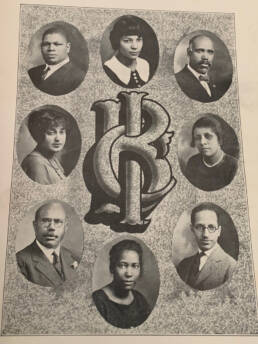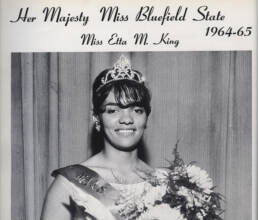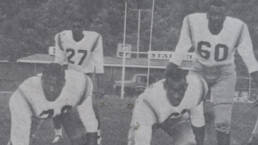Bluefield State College History
In February, 1895, Senator William M. Mahood sponsored a bill calling for the creation of what is now Bluefield State College. One year later, the educational institution created by that act of the West Virginia legislature welcomed its first students. For one hundred twenty years, Bluefield State College has focused on providing quality education in southern West Virginia. The College’s “Centennial Celebration” in 1995 furnished a highly-visible platform to look back at the accomplishments of the first century, then look to the opportunities and challenges ahead. The centennial theme, “Strong Past, Dynamic Future,” captured this very appropriate message.
The history of Bluefield State College is the heroic story of remarkable achievement in the face of seemingly insurmountable obstacles. The legacy of Bluefield State provides an inspiration and a challenge to those who follow.
The creation of Bluefield State College was the product of hard work by citizens of southern West Virginia who envisioned better educational services for African-Americans in the region. The dire need for coal miners created a huge population of black Americans who migrated into America’s last frontier wilderness during the latter years of the nineteenth century.
To serve the racially segregated public schools in the coal camps, progressive citizens of both races worked together to establish Bluefield Colored Institute (BCI), a “high graded school for Negroes,” in 1895. The new school was to be located on four acres on the north side of the Norfolk and Western Railway’s massive Pocahontas Division rail yards in Bluefield, a central location within 100 miles of 70% of West Virginia’s black citizens.



BCI began modestly with 40 pupils under the supervision of Hamilton Hatter, Bluefield State’s first president, although he was denied the prestigious title, instead serving as “principal.” Hatter oversaw the construction of Mahood Hall, the administrative building, as well as Lewis Hall and West Hall residence halls. Hatter was an energetic leader who built the foundation of the College. He faced enormous challenges, running the institution with no legislative appropriations whatsoever for two years.
In 1906, Hatter handed the reins of leadership at BCI to Robert P. Sims, a graduate of Hillsdale College, who would lead Bluefield State for three crucial decades. Sims showed dedication, commitment, and prudent management in his lengthy tenure at Bluefield State. By adopting formal teacher training–“normal education”–in 1909, Sims created the great role that Bluefield State would play, educating educators to Bluefield State College Campus Facilities Master Plan Bluefield, West Virginia December 2014 to carry traditions of excellence throughout the bustling coalfields, fulfilling the mission of its enabling legislation.
Enrollment climbed to 235 by 1920, with annual summer sessions for teacher certification attracting hundreds more. With efficient professional management and careful supervision, the College prospered, expanding to 23 acres, adding Payne Hall and colonnaded Conley Hall, faculty residences, and the stately President’s House. Enrollment soon exceeded six hundred, many of whom lived on the close-knit campus, termed the “terraced hills” for its verdant landscaping. Grateful graduates created the Alumni Association to rekindle collegiate memories and support programs of the institution. BSC students achieved notable distinction in a wide variety of fields.
Sims and his successor, Academic Dean and BCI alumnus Henry Dickason, president from 1936-1952, managed this growth with patience and resourcefulness. Bluefield State Teachers College, as the institution was renamed in 1931, was at the center of the rich cultural world of African-American society. Although the rough and tumble bituminous coalfields were far from the urban and sophisticated east coast, Sims and Dickason managed to involve their college heavily in the explosion of black American culture known as the “Harlem Renaissance,” bringing Langston Hughes to read poetry, John Hope Franklin to teach Negro History, and even heavyweight champion Joe Louis to boxing exhibitions in Arter Gymnasium. Fats Waller, Duke Ellington, Dizzie Gillespie, and Count Basie entertained the active Greekletter fraternities and sororities. Bluefield State’s “Big Blue” football team twice won national Negro College Athletic Association championships in the late 1920s.



A 1929 survey of the 702 alumni of Bluefield State demonstrated the college’s wide-ranging influence. There were no fewer than 326 school teachers, among dozens of administrators, physicians, pharmacists, ministers, businessmen and homemakers. The name “Bluefield State College” was adopted in 1943. After a half-century of inadequate salaries, extreme sacrifice, and passionate dedication, Bluefield State was finally awarded full academic accreditation in 1949 by the North Central Association, rewarding the institution’s measured progress.
Change again visited Bluefield State College. The 1954 Brown v. Topeka (Kansas) Board of Education U.S. Supreme Court decision declared racially segregated public education unconstitutional. Soon, white students seeking high quality, low cost, fully accredited higher education opportunities began to attend classes at Bluefield State. By 1962, 40% of the 643 undergraduates were European-Americans. By 1965, a majority of the 1,116 undergraduates were white. Certainly, change was again occurring.
Many factors affected the college’s transition, most importantly the loss of mining jobs as the coal industry rapidly mechanized. This shift in the racial demography of southern West Virginia subtly altered the role of Bluefield State. Soon, curricular change and personnel policies demonstrated the creation of new academic needs such as engineering technology and business administration.
However, tensions mounted in the wake of the school’s desegregation. The closing of residence halls and Bluefield State College Campus Facilities Master Plan Bluefield, West Virginia December 2014 the cancellation of the football program created alumni concern. Campus unrest involved meetings, protests, and finally the 1968 bombing of a campus building.
The early 1970s at Bluefield State saw five presidents in five years, as well as the temporary “coordinate relationship” with Concord College. Stability returned with the 10-year presidency of Jerold Dugger, when the college embarked upon the largest growth in its history. Under the subsequent presidencies of Gregory Adkins and Robert Moore, enrollment grew to a peak of nearly 3,000 and a record 637 graduates matriculated from the college in 1993.



Programming curricula broadened as well, adding advanced technology, instructional media capabilities, satellite conference facilities, continuing education courses, and increased involvement in the regional business community. The College continues to meet the educational needs of the region with state-of-the-art curricula and innovative programming. In 2014, students have opportunities to work side-by-side with faculty on laboratory research, engineering or robotics projects, or developing a small business plan. Internships offer students a head start on their career. The College also provides a global perspective through opportunities to interact with students from around the world, face-to-face, and through technology. The Bluefield State College Foundation has raised record sums from the area’s industrial base. Cultural awareness seminars help to revive the school’s storied past, and Bluefield State has established a College Archives to collect and preserve the traditions of the institution, including the history of the West Virginia Intercollegiate Athletic Conference which dissolved in 2013.
Bluefield State College stands proud of its past, but ever willing to adapt to meet the changing needs of the region it serves. Over 20,500 graduates have taken their experiences at Bluefield State College into the world, showing the wide-ranging influence of the College. The history of Bluefield State College is an inspiring and heroic story, a motivating and challenging epic of victory over great odds. The Master Plan that is outlined in the following pages honors that history and will take the institution to even greater heights.
Source: Bluefield State College Campus Facilities Master Plan, December 2014
Photos: Bluefield State College Library, Dr. Carl Boyd
